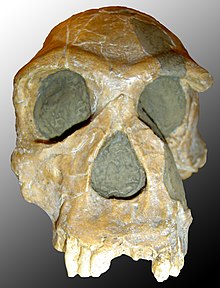Homo habilis
| Homo habilis Temporal range: Pliocene-Pleistocene
| |
|---|---|

| |
| Scientific classification | |
| Kingdom: | |
| Phylum: | |
| Class: | |
| Order: | |
| Family: | |
| Genus: | |
| Species: | H. habilis
|
| Binomial name | |
| †Homo habilis Leakey et al., 1964
| |
Homo habilis (Latin: "handy man") is one of the early ancestors of modern man who used primitive stone tools.[1] Their remains have been found in the Olduvai Gorge in Tanzania.[1] They are believed to be about 2 million years old. The flat face and large molars of the Homo habilis resemble the Australopithecus lineage. The brain size of the Homo habilis is about 700 cc (larger than the Australopithecus). An "apelike" (long arms and a small body) body structure was characteristic of the Homo habilis. They are believed to have been about 1.3 metres tall, and weigh about 37 kilograms.[2] There is still a lot of argument between scientists about the species.[1] They can not all agree on the characteristics, or whether it is even a separate species at all.
References[change | change source]
- ↑ 1.0 1.1 1.2 "Homo habilis". archaeologyinfo.com. Archived from the original on 26 May 2011. Retrieved 25 October 2010.
- ↑ "Homo habilis". handprint.com. Retrieved 25 October 2010.
Related pages[change | change source]
